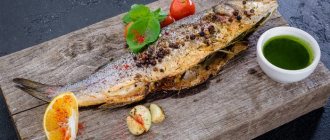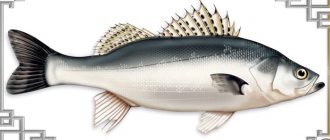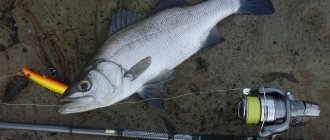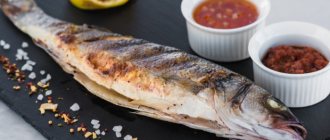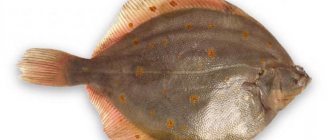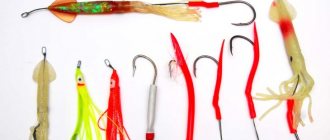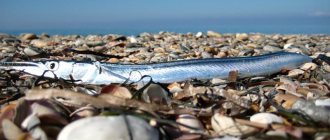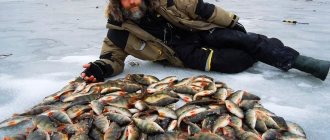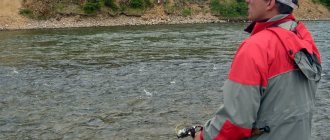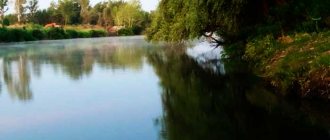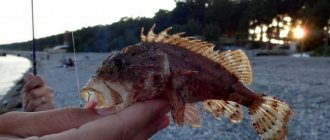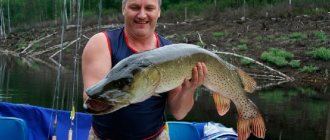Professional chefs and scientific nutritionists declare: sea bass is one of the elite fish delicacies, as it has high gastronomic qualities and confirmed dietary standards. This sea wolf (sea bass: ray-finned fish from the Moronidae family / order Moroniformes) is a recognized favorite of all admirers of seafood cuisine and lovers of proper (healthy) nutrition.
In many countries, this ichthyological exclusive has long been banned from mass fishing: the fish population is teetering on the brink of complete extinction.
What tastes better?
- Seabass 57%, 331 votes
331 votes 57%331 votes - 57% of all votes
- Dorada 43%, 252 votes
252 votes 43%
252 votes - 43% of all votes
Total votes: 583
08.10.2019
×
You or from your IP have already voted.
Let's get to know this sea predator better.
Chemical composition of sea bass
In its unique properties, sea bass is close to valuable species of salmon fish. It contains:
- polyunsaturated fatty acids – Omega-3 and 6, linoleic;
- vitamins A, D, PP, E, K, group B, especially the B12 content;
- minerals - phosphorus, potassium, iodine, calcium, iron, magnesium, selenium, chromium, zinc, manganese;
- essential amino acids that are not synthesized by the body - tryptophan, methionine, lysine.
Advice! A piece of boiled or baked sea bass is quite capable of replacing fish oil prescribed by a doctor.
Calorie content of sea bass
Despite its high saturation with fatty acids, sea bass has a low calorie content - 99 kcal. Per 100 grams of fish pulp there is only 3 percent fat. This fish is ideal for the dietary nutrition of people who lead a healthy lifestyle. Frequent consumption of sea bass helps strengthen the walls of blood vessels, helps reduce cholesterol, and saturates the body with minerals and vitamins. The zero glycemic index makes bay leaf an integral part of a diabetic diet. Sea bass is a storehouse of useful microelements for maintaining health in the body.
Useful elements
Microelements in 100 g of sea bass:
- iron – 0.844 mg;
- iodine – 59.037 mcg;
- cobalt – 29.407 mcg;
- manganese – 0.092 mg;
- copper – 119.406 mcg;
- molybdenum – 3.827 mcg;
- nickel – 5.882 mcg;
- selenium – 36.491 mcg;
- fluorine – 141.002 mcg;
- chromium – 54.967 mcg;
- zinc – 1.502 mg.
Macroelements per 100 g of fish:
- potassium – 298.483 mg;
- calcium – 119.327 mg;
- magnesium – 60.162 mg;
- sodium – 76.826 mg;
- sulfur – 209.436 mg;
- phosphorus – 221.428 mg;
- chlorine – 166.702 mg.
How many calories are in sea bass fish?
Despite the high content of healthy fatty acids, sea bass meat is low in calories, so it is recommended for overweight citizens, patients with gastrointestinal problems, children and the elderly.
100 g of sea bass contains:
- proteins – 16.5 g;
- fat – 1.5 g;
- carbohydrates – 0.6 g;
- 82 kcal.
Important! The calorie content of a finished dish largely depends on the method of its preparation. Oil used for frying or baking significantly increases the energy value of the product without adding any useful substances.
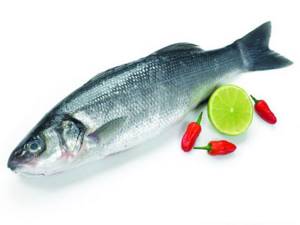
The most beneficial is boiled or steamed sea bass, with lemon juice and seasonings.
Seabass description and photo
Sea bass, laurel, sea wolf - these are the names of the same fish (by the way, the name of this fish is correctly pronounced like this: sibAs - the emphasis falls on the second syllable).
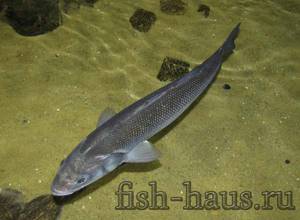
Sea bass habitat
It is found in the Atlantic Ocean and can be caught off the coast of Senegal and off the coast of Norway. It is found in both the Black and Mediterranean seas. In many countries, this fish is listed in the Red Book - its population is rapidly declining, since it is in great demand among restaurateurs. For example, good restaurants in Russia always have at least one dish made from bay laurel.
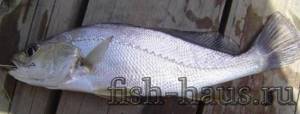
The sea wolf, also known as sea bass, is a predatory fish that feeds on small inhabitants of the deep sea - shellfish, shrimp, and small fish. This predator can wait for a long time for its prey in ambush; at the right moment it attacks, captures it with its huge mouth and swallows it.
Sea bass spawns once a year, usually from May to July, but there are varieties in which spawning takes place at a later time, closer to winter.
The largest specimens of sea bass can reach a length of one meter, and the weight can be more than 10 kilograms. On the market, the greatest demand is for specimens up to half a meter long and weighing no more than one kilogram. True, French buyers differ in this respect - they love large sea bass here.
Description with photo
The common laurel (Dicentrarchus labrax) is called differently in different parts of the Planet:
- sea wolf;
- koykan;
- sea bass (sea bass as “sea bass”);
- lubina;
- Brandzino;
- spigola;
- early.
Behind many names hides a predator widespread in the Atlantic Ocean and the Mediterranean and Black Seas.
Sea branzinos stay off the coast: young individuals in large flocks, and mature specimens - alone. Adult fish (from three to fifteen years old) weighing up to twelve kilograms often reach a length of one meter.
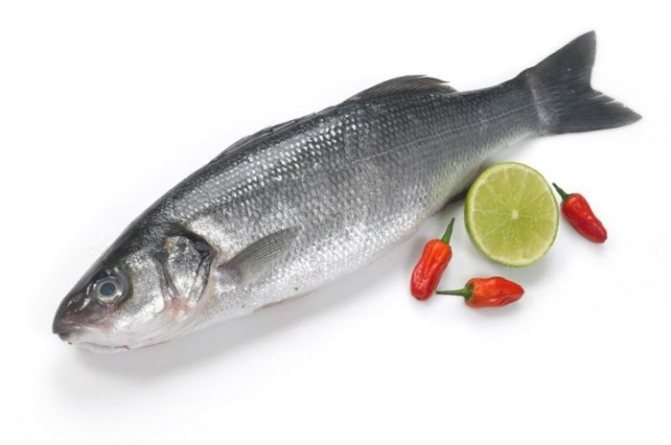
Everything in the appearance of this fish speaks of its predatory nature. Gray pale greenish scales, tightly fitting the swiftly muscular body. Fins converging to a cone, gill wings reinforced with spines.
This “silver killer” has a unique hunting style. Ranyo attacks from an ambush: he lies in wait for the prey in a shelter and, attacking with a sharp jerk, swallows the prey whole.
Interesting: due to its aggressive behavioral style and large toothy mouth, the sea bass is nicknamed the sea wolf.
Due to the reduction in natural reserves, sea bass is grown (breeded) in large fish farms (aquaholdings). Sea bass gains weight well (puts on fat) both in cages and in artificial pools with sea water. Fish grown in such conditions differs in size (weighs no larger than the standard 500 grams), is inferior in taste, but costs the consumer much less than its wild relatives.
Today, ichthyologists are well aware of two species of sea bass:
- “common” laurel, inhabiting the eastern coast of the Atlantic Ocean;
- Chilean (“black”) sea bass, found off the coast of the western Atlantic, Black and Mediterranean seas.
Lavrak
In the international ichthyological classification, sea bass exists under the toponym “common laurel”. This seafood is a real hit in the fishing industry. Entire fishing fleets ply the seas and oceans, catching the delicious sea wolf.
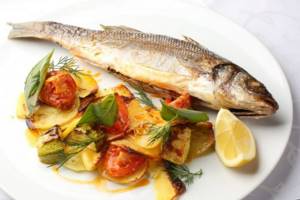
Lavrak lives near the coast and at the foot of cliffs, sometimes swimming into shallow mainland zones. These silvery predators are very active, constantly changing their locations, moving in huge herds. Common sea bass “walks” both on the surface and in the depths. The main habitats (places where sea bass are found) are the eastern part of the Atlantic, the Black Sea, and Mediterranean coastal zones.
The fatness and gastronomic quality of the fish depend on the fishing season. The tender white meat of fish caught early during spawning (May-July) is not as tasty as that of fish caught in trawl nets from August to October.
Lavrak is an icon of kitchen versatility: brandzino is suitable for any technological processes (recipe methods), dishes from this seafood always turn out tasty and unusually tender.
It is necessary to take into account: Russian fish markets operate mainly with sea bass from European aquaculture farms. “Wild protein” (fish grown in its natural habitat) is worth a lot of money all over the world.
Chilean (black)
Chilean (Patagonian) toothfish is the pinnacle of the premium segment of gourmet seafood. This type of sea bass is called “white gold” all over the world because of its tender meat and delicious taste.
The black (Chilean) species of laurel fish does not like sunlight and is found exclusively in deep (dark, cold) layers. The main habitat of this species is the American Atlantic coast (coastal waters of North Carolina).

The main visual difference between black brandzinos: dark grayish-brown color, predatory exterior body kit (fins with sharp rays-peaks).
But black ranyo is valued for its gastronomic qualities. Black toothfish is a storehouse of proteins, polyunsaturated fatty acids, vitamins, minerals, “wrapped” in the wonderful taste of the “wild” sea and low calorie content. All of the above creates stable demand and a fairly high price.
In Russia, it is not easy to purchase black sea wolf. To maintain excellent taste and the highest consumer qualities, this fish requires complex transportation (air logistics) and very responsible storage: which increases the already high price of the product.
In cooking, black brandzino is truly versatile: there are a huge number of ways to prepare Patagonian toothfish. Culinary experts strongly recommend grilling or stewing sea bass with exotic citrus fruits.
Fishing for sea wolf
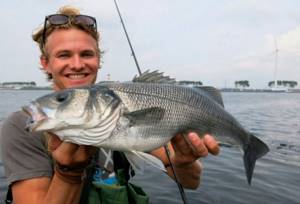
This predatory fish can be caught in two ways:
- Spinning.
- Fly fishing gear.
Each method has its own advantages and disadvantages.
Fishing for sea bass using a spinning rod
SEA FISHING IN CYPRUS. CATCHING SEA BASS and BARRACUDA using SPINNING from the SHORE
Spinning fishing involves the use of artificial baits. Any silver-colored spinners or artificial fish are suitable for catching sea bass. The sea wolf bites well on baits that imitate mackerel or sand eel.
As a rule, a spinning reel with a small multiplier is placed on the rod. The length of the rod is selected within 3-3.5 meters. Fishing is carried out from a steep bank, where sea bass swims to feast on small fish. Long casts are usually not necessary.
Fly fishing

To catch a sea predator, you should choose voluminous baits that are more similar to the silhouette of a fish. When fishing at night, you should choose black and red baits. With the arrival of dawn, you should switch to lighter baits, and in the morning switch to baits in red, blue or white shades.
For sea bass fishing, fly fishing gear of 7-8 classes, designed for fishing in salt water, is suitable.
Methods for preparing sea bass fish
Sea wolf is a premium fish, popular among chefs around the world for its almost boneless meat and excellent taste. Sea bass is universal. It tastes equally delicious no matter how you cook it. There are several ways to prepare sea bass:
- Fry in olive oil or simmer in tomato sauce.
- Bake in foil, stuffed with lemon and herbs, with vegetables.
- Steam, lightly sprinkling with lemon juice and vegetable oil.
- Boil in water with spices and herbs to taste.
- In restaurants you can enjoy sea bass baked in salt. When served, the salt crust is set on fire, and the dish looks impressive and tastes simply indescribable.
Recommended reading: Benefits of tomatoes for the body
Sea bass goes well with tomatoes and potatoes, carrots, onions and rice, zucchini, cauliflower and citrus fruits. Seasonings you can use include cumin and garlic, dill, basil, mustard and parsley, rosemary and turmeric.
We recommend reading: Turmeric: health benefits and harm, medicinal properties, applications
Sea wolf is a tender and low-fat fish. Therefore, it requires accuracy, a large amount of oil for frying and careful adherence to the recipe. It is important not to overcook the sea bass, so usually its cooking time does not exceed half an hour.
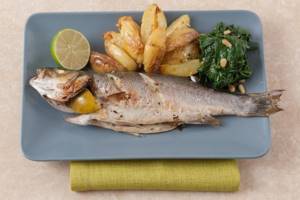
To prepare sea bass, it is better to use extra virgin olive oil.
Recommended reading: Benefits of boiled beets for the body
Spawning
From the age of two, sea bass fish are already capable of reproduction, although individuals living in ocean waters mature much later, at about 4-6 years. The spawning period for fish inhabiting the southern regions occurs in the spring, for the rest it occurs in winter. Spawning begins only after the water temperature becomes warmer than 12° C.
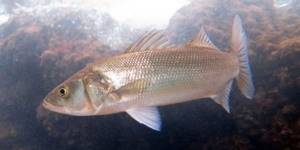
Sea bass spawning

Sea bass can spawn only after reaching maturity. The average age of maturation of females is 5 years. Comfortable temperature for spawning is about 15 degrees Celsius. Sea bass spawning begins in summer and ends in autumn. The fish prefers to spawn away from the shore. On average, a female can lay up to two million eggs. The eggs are small. The current carries them into the warm waters of bays and river mouths, where they grow and actively develop. The young will stay there for up to three years. Gradually they will migrate further into the sea and begin to migrate in search of food. Adult individuals annually migrate over long distances, from feeding grounds to spawning grounds.
Sea bass fishing gear
The following gear is used to catch this type of fish:
- A rod for fishing in salt water, the length of which must be at least three and a half meters and a weight of 50 grams.
- Inertia-free reel with a baitrunner system. It should also have a salt water protection system.
- The main line should be between twenty and twenty-two millimeters in diameter. Also, it is desirable that the fishing line be transparent and sink quickly. Its tensile test must be at least 4.5 kg.
- The weight should be flat and weigh from forty to sixty grams.
- Hooks should be used as sharp as possible with a rounded tip. It is better to select hook numbers 6 or 8.
- You can also try using streamer designs such as clauser or flatwing.
Tips for choosing
Before looking for how to cook fish, which is still unusual for many Slavs, experts recommend first familiarizing yourself with the rules for choosing products. This will directly determine whether the dish will be a success, or whether a dishonest seller will slip in stale goods.
When choosing the “highlight” for dinner, you should carefully study not only the appearance of the future purchase, but also the environment in which it was stored.
To make the right choice, you should always keep the following tips in mind:
- The goods should only be laid out on an ice bed in a special refrigerator. Fish piled up, slightly crushed with snow, without storage in refrigeration equipment may have internal signs of spoilage that cannot be seen immediately;
- The skin must be polished. This means that the color of the body must be uniform.
- The gills, like many other fish, should have a soft pink color;
- Eyeballs should be transparent.
You can also do a simple test to help determine the degree of freshness. If, when pressing on the carcass, the surface quickly levels out, then this is a good sign. But if the dent remains and does not take its original shape for a long time, this indicates preliminary freezing. In the latter case, it will be difficult to determine how many times the product was sent for freezing.
Another piece of advice, which is generally not mandatory, is the recommendation to purchase copies that are not particularly impressive in size. It is believed that such carcasses are easier to prepare, they lose less of their own juice during heat treatment and at the same time have a really delicate texture.
After purchasing, you should store your precious purchase in a plastic box, into which ice is first poured. The temperature should be between zero and minus two degrees.
If cooking is not provided right now, then it is better to freeze the sea bass until the required date. Just before throwing it into the freezer, you should definitely do the following manipulations: gut it, rinse it with water, and place it in a freezer bag. In this form, you can store supplies for up to a year without fear of possible damage.
Chilean analogue of sea bass
Bay laurel has a counterpart that is actually a different species. This is a Chilean sea bass, also called black sea bass. This fish received the definition of “black” not only for its dark color, but also for its ferocious disposition and appearance. Two sharp fins stick out on its back, which excites the imagination of some impressionable fishermen and consumers.
Chilean sea bass has nothing in common with sea bass by origin. In fact, black sea bass is a Patagonian toothfish. It belongs to the Nototheniaceae family. It is also mined in the Atlantic, but mainly in the Gulf of Mexico.
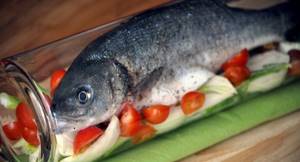
The lifestyle of black sea bass is also unique. It lives at great depths and loves cold water. The optimal water temperature for it is no higher than +11°C. Often such preferences are related not so much to temperature as to the oxygen content in the water. The fact is that there is more oxygen in cold waters. This is why many marine inhabitants prefer to live in the cold waters of the Sea of Okhotsk, and cetaceans generally breed off the coast of Greenland.
What contraindications do these species of aquatic vertebrates have?
No matter how useful a particular product is, it may still have contraindications for use . Sea bass is a fairly allergenic , so people who are prone to allergic reactions should limit their consumption. Dorado has virtually no contraindications, except for possible individual intolerance . This variety should be given to children very carefully, because it contains a lot of small bones. These vertebrate varieties are usually well tolerated by the body, so negative consequences from their consumption are rare.
Contraindications for sea bass fish
Sea bass has a number of contraindications. It should not be consumed by persons:
- with individual intolerance to this type of fish;
- those suffering from renal failure and liver diseases;
- with exacerbation of chronic gastrointestinal diseases.
Important! Children, nursing mothers and women during pregnancy are served sea bass only after heat treatment - boiled, steamed, baked. These categories should not consume smoked, salted or fried sea bass meat.
Can a child have sea bass?
Sea bass is one of those fish that can be given to children without fear of side effects or allergies. Boiled or steamed meat can be introduced starting from 9 months of age. Complementary feeding should be started little by little, with half a teaspoon, carefully monitoring the baby's reaction. If all is well, the daily norm is increased to 50 g. From one and a half years, the portion is 70 g, and after another six months - 80 g.
You can give your baby sea bass 1-2 times a week, preferably at lunchtime, carefully selecting all the bones and rubbing the boiled fish through a sieve. Due to the record amount of fatty acids, it is very useful for the proper development of the child. And its protein is easily digested without burdening the baby’s gastrointestinal tract.
What are the benefits of sea bass?
Due to its chemical composition, sea bass is extremely beneficial for health. It saturates the human body with vital micro- and macroelements, vitamins and amino acids. Sea bass is indicated for nutrition during pregnancy and for people on a diet.
Useful properties of this unique fish:
- Prevents the formation of cancerous tumors.
- Restores heart function, strengthens and cleanses blood vessels.
- Reduces cholesterol levels, serves as a prevention of atherosclerosis, early heart attacks and strokes.
- Relieves inflammation, removes waste, toxins and radiation from the body.
- Sea wolf normalizes weight, while saturating the body with essential nutrients.
- Helps increase fertility in men and women, so it should be included in the diet of couples planning to have a child.
- Raises tone, reduces the risk of nervous breakdowns, harm from stressful situations.
- Sea bass is an excellent prevention of diseases such as psoriasis, osteoporosis, arthritis and arthrosis, radiculitis.
- Improves brain function and perception of new information, speeds up thinking.
- Strengthens the regenerative functions of the body, restores the organs of vision.
- Increases immunity, slows down the aging process.
- Improves blood structure, prevents the development of rickets and promotes the proper formation of the skeleton.
- This fish is not only recommended for diabetes, but also necessary. The carbohydrate content of meat is so low that the glycemic index is zero, so it can be consumed without fear.
Advice! Sea wolf is perfect for feeding patients with pancreatitis and gastritis.
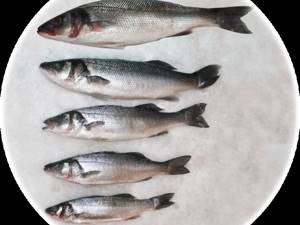
You should choose medium-sized fish, up to 50 cm, since adult specimens are less tasty and their meat can accumulate harmful substances
Potential Harm
Common laurel is considered one of the safest fish, allowed for almost everyone. But there are also some nuances. With all the listed advantages, any sea fish is allergenic. The main allergens are contained in the protein of the product. Therefore, this fish can be harmful for people with a history of allergies and an allergy to fish - this or that.
It is not recommended to consume sea bass for people with kidney failure, as well as for exacerbation of chronic diseases of the gastrointestinal tract.
Pregnant women, children, and lactating women should only serve fish that has been thoroughly heat-treated—boiled, steamed, baked. Smoked or salted laurel is prohibited for all these categories of eaters, as well as for people with kidney, gastrointestinal and liver diseases.

Sea bass fish: benefits and harm to the health of the body
True gourmets and professional nutritionists say: brandzino is in demand in the seafood market not only for its amazing gastronomic quality, but also for its effect on the consumer’s body (sea bass benefits). This exquisite seafood delicacy simply amazes with its rich chemical composition: strong fish proteins contain many antioxidants, vitamins, microelements, omega three and six acids. All useful components have long been taken into account by modern nutrition science (nutrition). Expert nutritionists are confident that sea bass:
- relieves the causes of most heart diseases;
- rehabilitates and stabilizes the nervous system;
- blocks problems of atherosclerosis, arthritis;
- improves vision;
- strengthens the functionality of the immune system;
- has a beneficial effect on the functioning of the genitourinary complex;
- eliminates insomnia, depression, irritability and other nervous properties;
- improving digestion, normalizes metabolism (metabolism).
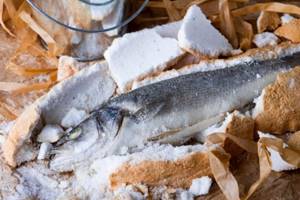
As is the case with most seafood, regular consumption of sea bass has a positive effect on the growth and condition of hair, skin, and nails. Many modern oncology practitioners recommend consuming seabass fillet saturated with iodine to prevent cancer pathologies.
Sea wolf fish is harmless to humans. Practitioner nutritionists guarantee: the main contraindication for laurel is only personal intolerance, allergy to strong proteins or iodine. All other “fish-eating gourmets” can safely enjoy this delicacy.
Weight and price
This seafood delicacy has a rather high price. At retail, chilled and fresh-frozen sea bass sea fish costs from 510 rubles per kilogram. Most often these are calibrated half-kilogram carcasses. In fact, this fish costs as much/what the consumer is willing to pay for it.
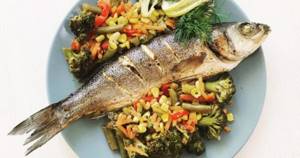
A rare auction participant (in our country), black toothfish (guaranteed to be caught in the natural environment) can be purchased for a starting price of 2,600 rubles.
Sea bass while breastfeeding
When breastfeeding, sea bass is a source of valuable substances in combination with easily digestible protein. If the baby is not allergic to fish, sea bass can and should be consumed. In most cases, children tolerate the addition of it to the nursing mother’s menu very well, without demonstrating diathesis.
It is best to choose marine fish caught in the Atlantic Ocean, because fish farmers, in pursuit of profit, add various chemical additives to the feed, which are far from harmless. When purchasing, you should pay attention to the type of carcass, the elasticity of the outer covers, the absence of a bad odor from the gill slits, which signals the beginning of rotting processes. It is important to make sure there are no parasites or fungal diseases.
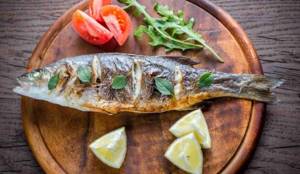
Regular consumption of sea bass has a beneficial effect on the condition of the skin, hair, and nails.
